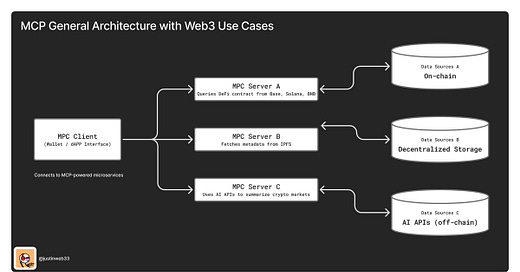Hi, it’s Marc.
Welcome to +134 new readers since our last update. Subscribe here to our other Web3 newsletter for business leaders. Today, we cover:
Top Reads
Alpha
Spotlight: MCP
Spotlight: Anthropic
Top AI Agents
“The future of crypto lies in Specialized AI Agents - powered by Specialized Language Models (SLMs) that understand context, nuance, and the fast-moving nature of Web3.”
Let’s jump in.
The Ultimate AI Agent Intelligence Platform
Discover, compare, and track AI vendors in real time — powered by research and data, not hype. Join the waitlist for exclusive early access 👉
Top Reads
Manus AI + Ollama: Build & Scrape ANYTHING (First-Ever General AI Agent) = OpenManus. Link
The Battle of the AI Agent Frameworks. Link
The AI Hype Index. Link
AI Agents in Cryptoland: Practical Attacks and No Silver Bullet. Link
The Future of AI is Decentralized. Link
Recent MCP adoption across Web2 and Web3. Link
Survival of the Fittest Detectors: A Decentralized Framework for Evolving Deepfake Detection. Link
Alpha
Fetch.ai's ASI-1 Mini, a Web3-integrated AI model, now supports Agentverse agents, enabling seamless query resolution through automated agent selection and execution.
Nillion introduced Genesis Validators, key players in nilChain, a network focused on Blind Compute—a privacy-first technology for Web3, launched with the $NIL token.
Sentient launched the Sentient Builder Program.
Olas introduced a $1M grant program, Olas Accelerator.
Zapier launched Zapier MCP, making it easy for AI Agents to take real actions across 8,000+ apps.
Sentient published a paper highlighting vulnerabilities in elizaOS, an AI agent framework managing over $25M, revealing how attackers can manipulate agents into unauthorized transactions via context manipulation attacks on platforms like Discord and X.
Heurist leverages the Model Context Protocol (MCP) to enable AI agents to perform blockchain tasks, like moving funds to high-yield vaults.
Arcium Network introduced the Arcium Purplepaper.
Mira Network launched its public testnet, processing 2B tokens daily and supporting 2.5M users.
Partnerships:
MIZU, a decentralized AI data infrastructure project, uses Nillion’s Blind Compute to ensure privacy in data processing, aligning with Nillion’s ecosystem focus on privacy-preserving tech.
The Masa x Bittensor Endgame Hackathon focuses on the Model Context Protocol (MCP), a system that connects AI models to real-time data.
The OpenGradient and LangChainAI integration is live.
Rayon Labs launched Squad, the first end-to-end agent platform on Bittensor, integrating Subnet 1 (Apex) for reasoning and Subnet 13 (Data Universe) for real-time data, with Macrocosmos providing support from launch.
👉Enjoying 51x? Subscribe to our Web3 newsletter for business leaders
Understanding MCP
MCP (Model Context Protocol), is an open standard developed to standardize how applications provide context to Large Language Models (LLMs).
It operates on a client-server architecture, where AI models (clients) can interact with MCP servers that manage connections to various tools and data. This architecture supports real-time data communication, dynamic tool discovery, and context handling, reducing development time and improving scalability.
Key benefits include:
Standardized Connections: Replaces custom integrations with a single protocol
Security: Offers built-in authentication and supports privacy-preserving computations
Flexibility: Supports multiple programming languages and operating systems
MCP: Web2 vs Web3
MCP in Web2 focuses on centralized, user-friendly setups with potential security risks, while Web3 MCP offers decentralized, trustless operations with robust privacy via TEEs.
Web3 tools with MCP integration
Heurist: https://github.com/heurist-network/heurist-mesh-mcp-server
Base: https://github.com/base/base-mcp
EVM Compatible server: https://github.com/mcpdotdirect/evm-mcp-server
Bankless: https://github.com/Bankless/onchain-mcp
Kukapay: https://github.com/kukapay/cryptopanic-mcp-server
Pancakeswap: https://github.com/kukapay/pancakeswap-poolspy-mcp
Uniswap: https://github.com/kukapay/uniswap-trader-mcp
The Graph: https://github.com/kukapay/thegraph-mcp
How do MCP Servers run in TEEs?
The MCP server operates within Trusted Execution Environments (TEEs) on Phala Cloud, a platform designed for secure, decentralized computing. TEEs, such as Intel SGX, create isolated enclaves that protect the server’s data and computations from external access, ensuring privacy and integrity.
TEE vs. Traditional Deployment
The MCP server runs in TEEs on Phala Cloud by being encapsulated within secure hardware enclaves, ensuring data privacy, code integrity, and secure computations.
More links on MCP:
Confidential Computing on NVIDIA Hopper GPUs: A Performance Benchmark Study
MCP server: A step-by-step guide to building from scratch
New Report: State of AI in 2025 – Beyond The Hype
Anthropic’s Approach Towards Interpretability
Anthropic dropped a research revealing how AI models like Claude actually think—exposing hidden planning, reasoning, and even deception.
A few key takeaways stand out:
A Universal "Language of Thought" – AI doesn’t think in English, French, or Chinese. It operates in an abstract space, mapping meaning across languages—echoing Chomsky’s Universal Grammar but in computational form.
AI Plans Ahead – The poetry case proves models don’t just predict the next word; they plan multiple steps ahead, challenging the assumption that AI is purely reactive.
Hallucination & Agreement Bias – Claude fabricates reasoning to align with user expectations—a major trust issue for AI in finance, medicine, and policy.
Parallel Thought Processes – AI combines different reasoning strategies (approximations, digit-wise calculations, pattern recognition) without understanding how—like deep learning models in image recognition.
AI as a "Microscope for Thought" – Just as neuroscience deciphers the brain, AI researchers are now reverse-engineering artificial cognition. The challenge? Scaling these insights into real-world reliability.
Why it matters: LLMs are notoriously opaque—trained on vast datasets, they produce outputs without clear explanations of their internal reasoning. This research is a significant step toward understanding AI "thinking," which has long been a holy grail in AI safety and development.
Our take: The tech is still in its infancy—more academic flex than practical fix. Case studies are cherry-picked; real-world messiness is a different game. Anthropic leans hard into the “ethical AI” narrative, but the community isn’t buying it. LLMs still fabricate facts, and this research doesn’t fix that—it just explains why.
The "AI Microscope" Problem: Cool in theory, but computational costs make it a non-starter for real-world deployment—at least for now.
Web3 Competitiveness: Anthropic’s transparency could outshine Web3 AI’s governance-based trust model, especially for enterprises that prioritize reliability over decentralization. As the tech matures and AI governance becomes a priority, both approaches will need to merge—transparent, interpretable models operating in a decentralized ecosystem.
The big question is: how do we make these insights actionable for businesses, policymakers, and end users? Understanding AI at this level is one thing—controlling and aligning it is another.
More links on Anthropic:
Top AI Agents by mindshare
Some agents you want to keep an eye on:
$VIRTUAL ($445M): A framework and infrastructure designed to create, deploy, and monetize autonomous AI agents across various platforms and applications, such as gaming, entertainment, social interactions, and more.
$FAI ( $220M): AI built with publicly available large language models (LLMs) and operates on the Base blockchain.
$AI16Z ($210M): Solana-based web3 platform that employs a unique AI agent-driven VC investment model and community-driven DAO governance.
$TRAC ($197M): A decentralized knowledge-sharing protocol and blockchain-based platform that uses a Decentralized Knowledge Graph (DKG) to organize, verify, and share trusted data and knowledge assets across industries.
$AIXBT ($103M): A crypto-savvy AI that scans markets and social media to deliver trading insights and alpha opportunities.
$PAAL ($101M): Personalized, advanced AI assistants and applications, particularly for crypto investors and broader digital communities.
$PHA ($91M): A decentralized blockchain platform focused on providing secure, privacy-preserving computation for Web3 applications.
$ARC($52M): A modular toolkit for creating AI bots that are highly customizable, especially for crypto ecosystems.
$GRIFFAIN ($42M): Creates AI tools that make AI agents smarter and more efficient, like enabling them to trade on DeFi protocols.
$SWARMS ($37M): Focuses on teams of AI bots (“swarms”) that work together to tackle big challenges.
$ZEREBRO ($34M): Autonomous AI system designed to create, distribute, and analyze content across decentralized and social platforms like X and Instagram.
That’s it for now.
– Marc & team














